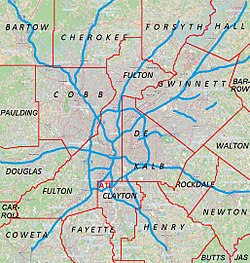Archibald Smith House | |
 Archibald Smith Plantation Home in February, 2008 | |
| Location | 935 Alpharetta St., Roswell, Georgia, U.S. |
|---|---|
| Coordinates | 34°1′26″N84°21′36″W / 34.02389°N 84.36000°W |
| Built | 1845 |
| Architect | Denny Gentry |
| Architectural style | Georgian |
| NRHP reference No. | 06000740 [1] |
| Added to NRHP | August 30, 2006 |
The Archibald Smith Plantation Home is a historic house in Roswell, Georgia, built in 1845. The home was built by one of Roswell's founders, Archibald Smith, and housed three generations of his family.


